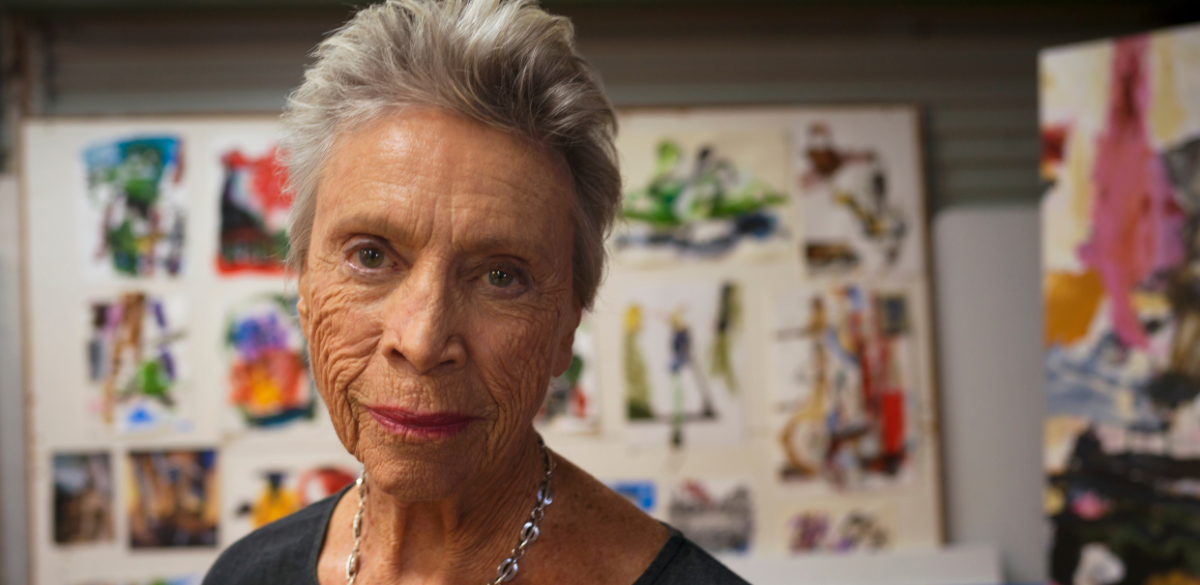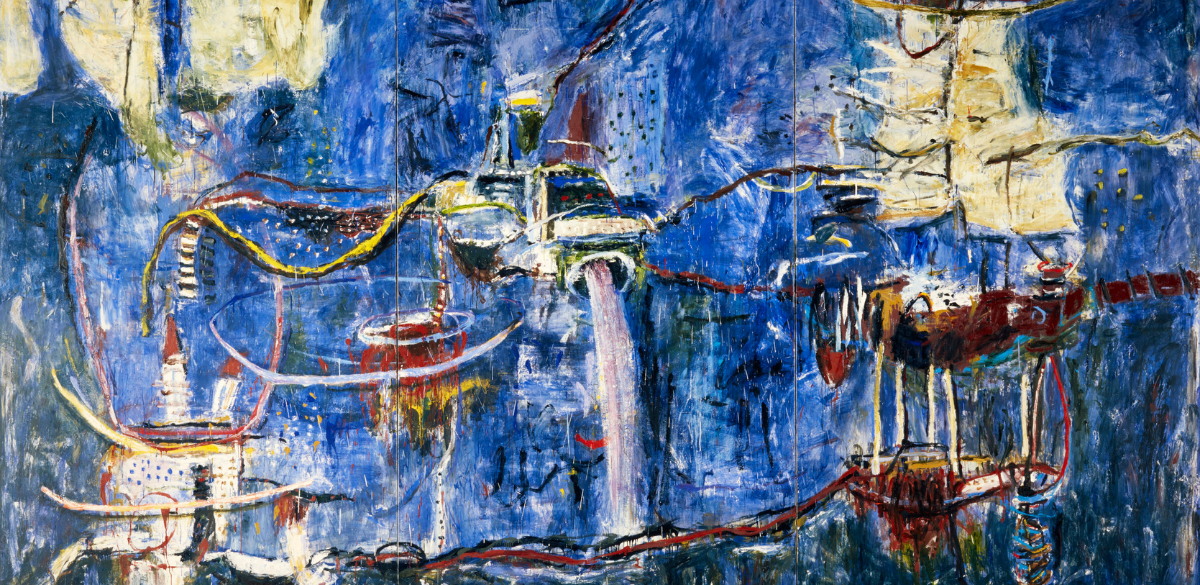
A Lasting Impression
Creating a legacy collection with Ann Thomson
Written by Vicky Roach
Photography by Andres Smetan
ICC Sydney is home to the nation’s most significant collection of large format art works. We spoke to Ann Thomson, one of 10 leading Australian artists commissioned to respond to Sydney, its harbour and its foreshores on an awe-inspiring scale.
A 5.5-metre-tall blank canvas is a daunting prospect, says Ann Thomson, even for an artist who thinks big. Three-level scaffolding was installed at a temporary studio at Walsh Bay’s Pier 6/7 to enable the distinguished painter and sculptor to work on her 1988 commission, Ebb Tide, which is part of ICC Sydney’s $23 million art collection.
“I remember, once, not bothering to put the third rung up and teetering on a milk crate at the top. O, H & S? We didn’t have that in those days,” she laughs. Looking back, now, at her muscular, abstracted vision of a working Sydney Harbour, Thomson says Ebb Tide strikes her as a young person’s painting. “It’s adventurous and ambitious, all those things that come with youth and enthusiasm… leaping into something I couldn’t have envisaged when I started.”
To prepare, Thomson drew dozens of sketches. “When I got to Walsh Bay, I pinned them all up on the wall and then I never looked at them. It says quite a lot about the way I paint. The painting just takes me in.”
Thomson describes a work of Ebb Tide’s scale as “a glorious challenge”.
“Was it daunting? Just a bit. But if you can pull it off, in a space like that, it’s good. And I feel like I pulled it off.”
Thomson’s painting was one of 10 monumental works by leading Australian artists, including John Olsen, Charles Blackman and Brett Whiteley, commissioned for the original Darling Harbour convention centre, which opened in 1988 in celebration of Australia’s Bicentenary. Their brief was to respond to Sydney, its harbour and its foreshores.

Thomson worked on her painting at Walsh Bay for the best part of three months, alongside Olsen, Whiteley and Archibald Prize-winner Tim Storrier. “It was like an artist’s workshop,” says Museum of Contemporary Art founding director Leon Paroissien. “That’s one of the images that sticks in my mind. The fact that these artists—some of whom are no longer with us—actually worked together, could see what one another was doing.” Thomson recalls the environment being “competitive—in a friendly way”. “I do remember when the other artists left—they finished a lot sooner than I did—I was able to move my scaffolding into the best space, which was John Olsen’s, and the light was better there, him being an old pro.”
According to Thomson, Whiteley initially declined the commission. “He wasn’t going to do it: ‘not enough bread man’.” After the late, great Australian artist reconsidered, the two painters bonded over the colour blue.
“When the paintings were finished, we used to catch up and have coffee sometimes and we talked about painting,” says Thomson. “We talked about blue and the depths of blue and the space that blue could make that no other can. He was good to talk to. I think he really liked my painting. When he died, his mother told me he admired it. All those artists did good paintings. They were very special.”
Thomson and Sandra Leveson were the only two women painters commissioned for the 1988 collection—a sign of the times. A small number of high-quality paintings by Indigenous artists such as Long Jack Phillipus Tjakamarra and Charlie Tjapangati were also selected. More works by significant Aboriginal and Torres Strait Islander painters such as Ronnie Tjampitjinpa and Gloria Tamerre Petyarre have been added in the intervening years.

“It’s an extremely valuable collection,” says Paroissien, who advised Darling Harbour Live on the reinstallation of the paintings when ICC Sydney was rebuilt, in 2016, as part of a $3.5 billion revitalisation of the cultural precinct. Five new spaces were created as galleries to better display what is often referred to as “Sydney’s secret collection”.
Many of the larger Bicentenary commissions, including Ebb Tide, have been rehung in what Paroissien describes as a “remarkable space” near the main entrance, at the northern end of ICC Sydney.
“Because of the escalators, the works flow up through it. You have to actually choose the right level to see some of them and that makes it stand out.”
Thomson has been painting since she was nine years old. “That’s what I mostly did at school. I spent a lot of time in the art room.”
When her children were young, the artist worked at night, after they had gone to bed. Returning to work full time, Thomson says, she was like an arrow coming out of a bow; “thwim, it all came out. I painted furiously.” And she hasn’t really stopped since. “That’s what I do. Although I’m certainly not painting as hard and fast as I have done.”
Thomson recently returned home—a converted lemon butter warehouse in Sydney’s Eastern Suburbs, which doubles as her studio—from Hong Kong, where she exhibited alongside fellow Australian artist and former student Joe Furlonger.
Sanbao, at the NockArt Gallery, was the culmination of an artist residency, the previous year, in Jingdezhen, the ceramic capital of China. “I would go to the factory and point to these big vessels and they would carefully bring them down for me to work on. I loved it,” she says. At 85, Thomson certainly hasn’t lost her appetite for an artistic challenge.

